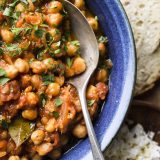The Greek island of Ikaria has a wealth of vegetable dishes. Savory baked eggplant with sweet carrots. Lemony rice-stuffed zucchini. Warm potato salad with oregano and oil. It’s a bounty for which we can thank piety and pirates.
Start with the pirates. Centuries of seaside villages being sacked drove locals inland, creating a cuisine mostly devoid of the seafood around them. Now add the Orthodox faith, which requires meat- and dairy-free diets 40 days before both Easter and Christmas, as well as two weeks in August, plus every Wednesday and Friday the rest of the year.
The result is a way of eating that puts vegetables at the center of the plate. “That’s something that’s quite unique in Greek cooking, that most vegetable dishes are considered main courses,” says Diane Kochilas, an expert on the cuisine who lives part of the year on Ikaria.
Many of those dishes call for lavish amounts of legumes, often braising them in olive oil and tomato—a broad category of dishes called ladero. Citrus and sugar (typically honey) also make frequent appearances, a sweet-savory hallmark of the island’s cuisine that is used to transform otherwise simple dishes.
While showing me one such dish made with chickpeas, Kochilas spoons the cooked beans into a baking dish, then uses a rough-textured wooden reamer to juice an orange over them. “Orange is one of my favorite things to use, in everything,” she says.
The remaining ingredients are simply layered one at a time. A can of diced tomatoes, which Kochilas prefers for this dish over fresh for their more intense flavor. A spoonful of fruity grape molasses, though sometimes she uses rich Ikarian honey. Chunky chopped red onion. And from her herb garden outside, fresh bay leaves, sprigs of rosemary and oregano with the tiny white flowers still attached.
A hearty, imprecise glug of olive oil covers it all, then into the oven for about an hour, by which point the onion and tomato have cooked down to a jammy sauce coating the tender chickpeas. Slightly sweet and aromatic of orange and herbs, the dish indeed makes a satisfying main.
Back at Milk Street, we were intrigued by Kochilas’ marriage of sweet and savory, and how it elevated the simple chickpea. We stuck close to her recipe, adjusting mostly to deepen flavors and speed cooking by keeping it on the stovetop rather than in the oven.
For depth, we browned tomato paste with the olive oil and honey, then stirred in canned chickpeas for ease. Canned tomatoes, fresh herbs, red onion, orange juice and garlic rounded out the recipe. We then simmered everything until, like Kochilas’ version, the tomatoes and onion were jammy and rich. Orange zest and fresh oregano stirred in at the end added a fresh, floral character that reinforced the rosemary and honey.




